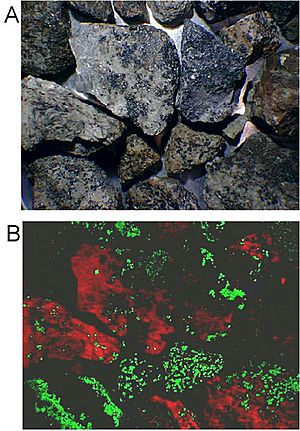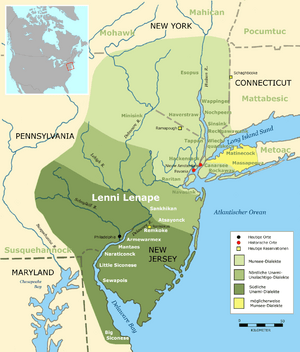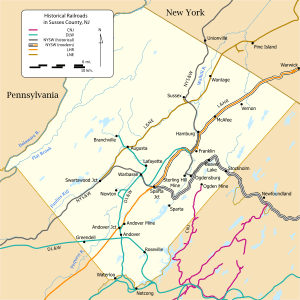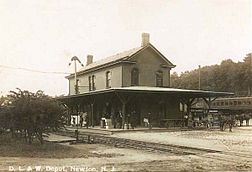History of Sussex County, New Jersey facts for kids
The history of Sussex County, New Jersey covers more than 13,000 years. It starts when the first people, called Paleo Indians, arrived after a huge glacier melted. It continues all the way to today, showing many parts of the American story.
Before Europeans came, this area was a wild place. It had large forests and grasslands. Munsee people lived here. They were a group within the Lenape, also known as the Delaware Indians. In the early 1600s, the Netherlands claimed the land, but they never settled it. Dutch settlers from the New Netherland Colony were the first to build homes here in the early 1700s, after England took control. Later, in the 1700s, Sussex County welcomed German families from Philadelphia, Dutch families from New York, and other British settlers.
Contents
- Ancient Times: Paleo Indians and Early Hunters
- Rock Shelters and Caves: Homes of Early People
- Lenape Native Americans: Life Before Europeans
- European Settlement: New Beginnings
- How Sussex County Was Formed
- Sussex County in War: Protecting the Frontier
- Farming and Industry: How People Made a Living
- Railroads: Connecting the County
Ancient Times: Paleo Indians and Early Hunters
The land we now call Sussex County was first settled by Paleo Indians. This was around 13,000 B.C., as the Wisconsin glacier melted. For thousands of years, the whole county was covered in ice, hundreds of feet thick.
After the glacier melted, the area slowly got warmer but stayed cold and wet. There was a lot of cold water from the melting ice. Huge lakes and swamps were everywhere. At first, the land was like a tundra, with mosses and lichens growing. Later, grasslands appeared. As the climate warmed over a thousand years, thick forests grew.
Big animals like mastodons, mammoths, giant beavers, and caribou came to the area. Smaller animals like rabbits and foxes were also here. Paleo Indians moved into the area around 11,000 B.C. They lived in small groups, always moving to find game and plants. They were hunter-gatherers, eating berries, plants, and hunted animals. They also ate freshwater clams and fish like shad and sturgeon. They caught fish with spears or traps made of stones and sticks.
Paleo Indians made spear points from jasper, quartz, shale, or black chert. They traveled to special places to find these stones or traded with other groups. They also used atlatls, which are sticks that help throw smaller spears. They lived near water because that's where most animals and plants were. They moved when food became hard to find. Their old campsites are deep underground, making them hard to find today.
Mastodons lived in the area during the Paleo Indian time. Mastodon bones have been found in places like Highland Lakes and Swartswoods Lake. These findings show that mastodons were here when Paleo Indians traveled through. We don't know for sure if Paleo Indians hunted these huge animals, but it's possible.
As the climate warmed, big animals like caribou moved north. Other animals like the giant beaver, mammoth, and mastodons died out. Some Paleo Indians followed the caribou north.
There are several places where Paleo Indian activity has been found. The Zierdt site is near the Delaware River. Dutchess Cave in New York, the Shawnee site in Pennsylvania, and the Plenge site in Warren County are also important. Other places like Bevans Rock Shelter and Glenwood Cave might have been used by Paleo Indians too.
As the climate warmed, spruce and pine forests grew. There were still grasslands, especially in wet areas. Other large animals like elk, bison, moose, and deer moved into the area. Fishing became very important because it was harder to hunt big game in the thick forests. Ducks and bird eggs were also eaten.
Around 8000 B.C., the climate became warmer and drier. Hemlock trees started to grow, followed by trees like oaks and maples. By this time, most mastodons were gone. This was the start of the Archaic period. During this time, people ate oak nuts and other seeds.
Around 3,000 B.C., trees like beech, walnut, hickory, chestnut, and butternut grew. These trees provided nuts, and the number of Archaic hunters grew faster. The Archaic period lasted from 8000 B.C. to 1000 B.C. As more people lived here, large families became small tribes.
Around 1000 B.C., people started using clay pottery. This was the beginning of the Woodland Period. With pottery, Native people could cook food better and store it. Around 500 A.D., the bow and arrow were invented. This meant Native Americans could hunt from farther away, getting more food.
Rock Shelters and Caves: Homes of Early People
Sussex County has many rock shelters, which are natural overhangs or caves that early people used for protection. There are 25 known rock shelters in the county. Early hunters chose places near water and food.
Bevans Rock Shelter: A Large Home
The Bevans Rock Shelter is the biggest rock shelter in Sussex County. It's located west of Bevans village in Sandyston Township. There are three shelters here, with the largest in the middle. The main shelter faces east and is next to a swamp. Huge boulders hang over a 5-meter drop in the ground. There's an opening at the end where a person can climb to the top.
Buttermilk Falls Rock Shelter: Near a Waterfall
The Buttermilk Falls Rock Shelter is 75 meters upstream from the top of the falls. It faces northeast and is close to the creek. The shelter is shaped like a triangle. It's about 1.75 meters high at the front and 0.75 meters high at the back. It's 4 meters wide at the opening and 2 meters wide at the back. This shelter is in Walpack Township.
Glenwood Creek Cave: A Small Hideaway
This is a small cave at the bottom of a rock cliff, right at water level, on the north side of Glenwood Creek. The cave is 2 meters wide, 1.75 meters high, and 2 meters deep. It could only be used when the creek's water levels were low, like in late spring through early autumn. This cave is located in Vernon Township.
High Point Rock Shelters: Near Fresh Springs
These two rock shelters are in High Point State Park. They are 500 meters east of Lake Marcia. The shelters are 3 meters apart and are each about 1 meter high and deep. There are fresh water springs nearby, which was helpful for early hunters.
Moody's Rock Shelter: A Huge Shelter
This is a very large rock shelter in Andover Township. It faces southeast on the edge of a swamp. The shelter is 22 meters long, 4 meters high, and 3 meters deep. It's one of the biggest shelters in the county. There's also a smaller shelter nearby.
Tom Quick Cave: A Temporary Spot
This narrow cave faces southwest. It's about 42 centimeters wide, 3 meters high, and 12.5 meters deep. This cave was likely used only for short stays during bad weather because it's very narrow. There's a fresh water spring and the Delaware River nearby.
Vultures Cave: By the Delaware River
This unique cave and rock shelter is on the eastern bank of the Delaware River in Montaque Township. It faces northwest and is about 1 meter above normal water levels. There are several openings and tunnels within this shelter.
Lenape Native Americans: Life Before Europeans
When Europeans first arrived, the Lenape people, also known as Delaware Indians, lived in the mid-Atlantic coastal areas and along the Hudson and Delaware rivers. The Lenape believe they came from the Mississippi River area around the year 1000. Their villages were along the Delaware River and other rivers that flowed into it.
In the early 1600s, a period called the Little Ice Age made life harder. Late and early frosts made it difficult to grow important crops like corn, beans, and squash. Cold weather also made it harder to find animals, and nut crops sometimes failed. Rivers froze early, making fishing impossible.
Native American populations also dropped sharply because of diseases brought by Europeans. Native Americans had been separated from Europe for thousands of years and had no protection against these new illnesses. Many were already weak from hunger due to the Little Ice Age. As their population decreased, more land became available for European settlers. Land was also bought, sometimes fairly, sometimes through trickery. By 1750, very few Native Americans were left in Sussex County. The Treaty of Easton in 1758 forced the remaining Native Americans in New Jersey to move west or north to Canada.
European Settlement: New Beginnings
In 1609, Henry Hudson explored eastern North America for the Dutch. Because of his trip, the Dutch claimed a large area, including what is now New Jersey. They settled the Hudson River Valley and traded furs with Native Americans.
In 1664, the English took control of the land from the Dutch. New Jersey was then divided into two parts: East and West Jersey. The western border of Sussex County became the Delaware River.
Dutch settlers began moving southwest from the Hudson River area towards the Delaware River. As early as 1690, Dutch and French settlers from New York started living permanently in the Upper Delaware Valley, known as the "Minisink." They settled the Port Jervis area. These settlers followed old Native American trails, which later became routes like the Old Mine Road.
German families, who were refugees from wars and harsh winters, arrived in Philadelphia and New York City in the early 1700s. Some settled in northwestern New Jersey in the 1720s. Later, in the 1740s and 1750s, Scottish and English settlers from other parts of New Jersey, Long Island, and New England also moved into the eastern parts of what would become Sussex and Warren counties.
After the French and Indian War, there was a border dispute between New Jersey and New York. This was settled in 1769, establishing the northern border of Sussex County.
How Sussex County Was Formed
Sussex County was first part of Burlington County in 1694. Then it became part of Hunterdon County in 1714, and later Morris County in 1739.
By the 1750s, people living in this area wanted their own county. They complained that it was too far to travel to do business with the government and courts. Four large townships already existed: Walpack, Greenwich, Hardwick, and Newtown. On June 8, 1753, Sussex County was created from a large part of Morris County. At that time, Sussex County included what are now Sussex and Warren Counties, and even a part of New York State.
The county was likely named by Governor Jonathan Belcher after the Duke of Newcastle, whose family home was in Sussex, England.
In the early 1800s, residents in the southern part of the county wanted court sessions closer to them. So, on November 20, 1824, Warren County was created from the southern part of Sussex County.
Sussex County in War: Protecting the Frontier
French and Indian War (1756–1763): Raids and Forts
Soon after Sussex County was formed, fighting between the British and French spread to North America. This was because both sides claimed land in western Pennsylvania. Native American tribes often sided with the French because they felt mistreated by the British.
During the French and Indian War, Native American groups sometimes raided Sussex County. In 1756, a group of Lenape attacked homes, killing some settlers and kidnapping others. To protect the frontier, the governor approved a plan for 8 forts to be built along the Delaware River. These forts were manned by the New Jersey Frontier Guard. Some were small blockhouses, others were fortified homes. These forts stretched from Phillipsburg north to Port Jervis, New York.
Most of the fighting ended with the Treaty of Easton in 1758. This treaty made peace between the government and the Lenape. The war officially ended in 1763.
American Revolution (1775–1783): A Daring Rescue
During the American Revolution, a loyalist named Lieutenant James Moody led a brave raid. In 1780, Moody and his men went to the Sussex County Courthouse. They freed eight loyalist prisoners held in the jail in the basement. Moody and the freed men escaped, and even though Revolutionary forces chased them for days, they were not caught.
Farming and Industry: How People Made a Living
Dairy Farming and Agriculture: From Subsistence to Science
Early settlers in Sussex County mostly grew enough food for their own families. Because of the land, dairy farming became very important here. Some farms also had apple and peach orchards. Farmers would trade or sell any extra food. This way of life continued until the mid-1800s.
Then, new ways to preserve food and the arrival of railroads changed everything. Sussex County farmers could now send their products all over the region.
In 1914, a man named James Turner invested a lot of money to create Lusscroft Farm in Wantage Township. He wanted it to be a perfect model for dairy farming and to use science to improve farming. In 1931, Turner gave the farm to the State of New Jersey to be an agricultural research station. Rutgers University used the farm for research until 1996. Research at Lusscroft Farm led to new ways of farming, livestock breeding (like artificial insemination for dairy cows), and testing milk to make sure it was safe. Today, Lusscroft Farm is part of High Point State Park and teaches people about farming history.
Iron Mining: Fueling a Nation
The Highlands Region of Northwestern New Jersey has rich deposits of iron ore. In the mid-1700s, people started mining iron in Sussex County. They built forges and furnaces to make iron. By the late 1700s, almost all the trees in Sussex County were cut down to make charcoal, which fueled these ironworks.
In 1749, William Allen and Joseph Turner bought a lot of land, including the "well known Andover mine." This mine was important during the American Revolution. In 1777, the Continental Army needed iron for the war. When Allen and Turner, who supported the British, refused to sell, the army took over the Iron Works to equip General Washington's army.
The Andover mine was later reopened and produced a lot of iron ore. This iron was used to build railroad tracks and the country's first structural steel, which helped build railroads and develop the county. Iron from Andover was used for the bridge at Niagara Falls and to rebuild Princeton University's Nassau Hall. During the American Civil War, Andover iron was used for rifle barrels and cannonballs.
In the 1870s, the famous inventor Thomas Edison tried to find new ways to process low-quality iron ore. He built one of the world's largest ore-crushing mills near Ogdensburg, New Jersey. It used huge electromagnets to separate iron from other materials. However, richer iron deposits were found in Minnesota, making Edison's operation unprofitable, and he closed it in 1900. Edison then used his ideas and machines for the cement industry.
Zinc Mines and Fluorescent Minerals: A Glowing Discovery

After medical school, Samuel Fowler settled in Franklin, New Jersey. He became known for his interest in minerals, especially zinc. He discovered several rare minerals that glow in bright colors when exposed to ultraviolet light. Because of this, Franklin is known as the "Fluorescent Mineral Capital of the World." Fowler bought and operated iron and zinc mines in the area.
After Fowler's death, two companies were formed to mine the iron and zinc. These companies later merged to form the New Jersey Zinc Corporation. Mining companies in the area often had legal battles over land claims. Eventually, all the companies in the Franklin District were combined under the New Jersey Zinc Company.
Many immigrants from Russia, Britain, Ireland, Hungary, and Poland came to Franklin to work in the mines. The town's population grew from 500 in 1897 to over 3,000 in 1913.
The Palmer family controlled the company for 46 years. However, by the 1970s, the mines in Franklin had less ore, and it was expensive to pump water out of them. This led to the mines closing. Today, both the Franklin and Sterling Hill mines are museums.
Railroads: Connecting the County
Today, only one freight train line operates in Sussex County. But in the past, many railroad companies had lines here. Trains were very important for the county's dairy and mining industries. As these industries declined, and trucks became more common for transport, railroads lost business. Most stopped operating in the 1960s and 1970s.
Now, many old railbeds have been turned into fun recreational trails. Soon, passenger train service will return to Sussex County for the first time in almost 50 years with the reopening of the Lackawanna Cut-Off.
The Sussex Railroad was started in 1848 to carry iron ore and products. Construction began in 1853, and the line reached Newton the next year. It was later extended to Branchville, Lafayette, and Franklin. This was the first railroad in Sussex County and helped the dairy and mining industries grow. The Sussex Railroad operated until 1945. The last train ran in 1966, and the tracks were removed. Today, the old railbed is a recreational trail called the Sussex Branch Trail.
From 1886 to 1962, the New York, Susquehanna and Western Railway operated a line that followed the Paulins Kill valley. This railway mainly transported coal from Pennsylvania to New York City. In the late 1980s, New Jersey bought the abandoned railbed and turned it into the Paulinskill Valley Trail. This 27-mile trail is used for hiking, cycling, jogging, and horseback riding.
In the early 1900s, the Delaware, Lackawanna and Western Railroad opened a long main line from Hoboken, New Jersey, to Buffalo, New York. A part of this line, called the Lackawanna Cut-Off, was built across the southern part of Sussex County from 1908 to 1911. It was used until 1979. This route is now being rebuilt by New Jersey Transit and is planned to open in 2014. The Lackawanna Cut-Off is a great example of early 20th-century railroad building, designed with minimal slopes and curves and no road crossings. It was one of the first railroad projects to use a lot of reinforced concrete.





